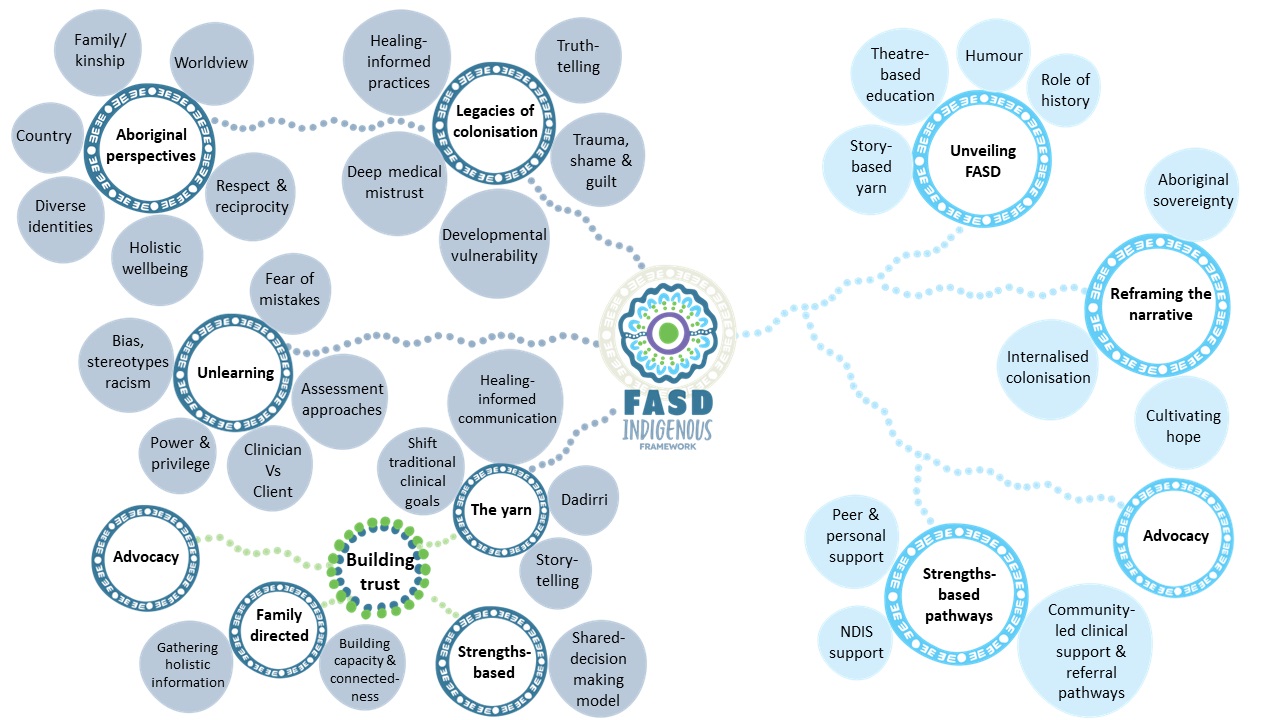(4 mins)
Blending Aboriginal and Western wisdoms, taking a healing-informed approach, and facilitating two-way learning at a grass roots level are keys to improving outcomes for Aboriginal communities living with Fetal Alcohol Spectrum Disorder (FASD), according to a new study.
Published in March 2023, an Australian FASD Indigenous Framework was developed in collaboration between Aboriginal and non-Aboriginal peoples and sets out the steps that non-Indigenous health professionals and Aboriginal communities can take to facilitate equitable access to culturally responsive, healing-informed and strengths-based FASD knowledge, assessments, diagnosis and supports.
Nicole Hewlett, lead author and researcher at the University of Queensland, explains how this new framework offers hope and healing for all Australians living with FASD.
Steppingstones towards better outcomes
The Framework brings together Aboriginal Wisdom, which is inherently strengths-based and healing-informed, with Western Wisdom and its biomedicine and therapeutic models.
Drawing on both, the study identifies changes that can be made in the knowing, being and doing of Aboriginal peoples and non-Aboriginal clinicians to ensure the best outcomes for those living with FASD.
“It is important to have an Australian FASD Indigenous Framework to firstly give hope to Aboriginal families living with FASD, that may be forgotten, powerless and voiceless as they endure normalised cycles of trauma, poverty, grief, loss and injustice. Secondly, it is important that Aboriginal peoples and non-Indigenous clinicians have realistic, solutions-focused and action-oriented steppingstones to guide how they can apply a strengths-based, healing-informed and culturally responsive approach that will effectively address FASD and transform current realities.”
- Nicole Hewlett, Project Manager, First Nations Cancer & Wellbeing Reesarch Team, The University of Queensland.

The Framework identified several strategies to guide non-Aboriginal clinician to better support Aboriginal peoples (dark blue circles), including:
- Critically understanding the role and ongoing impacts of colonisation and developing a deep respect and appreciation for diverse Aboriginal perspectives, unlearning practices that give rise to bias, stereotypes and racism
- Building the capacity and connectedness of the family or support system to live well with FASD and embed a holistic, strengths-based and sustainable approach in these supports.
- Applying healing-informed and strength-based approaches that are grounded in Aboriginal understandings of wellbeing.
For Aboriginal Communities (light blue circles), considerations include:
- Drawing on cultural strengths to build meaningful understanding of FASD at a local level.
- Understanding the narratives that exist at an individual and community level and draw on the strength of Aboriginal sovereignty to build personal and collective skills to take control of these narratives.
- Drawing on the expertise that each community inherently has, build local capacity to apply this expertise to inform local pathways and solutions that resonate with the local community’s unique ways of knowing, being and doing.
Two-way learning, respect and trust is key
At the heart of the Australian Indigenous FASD Framework is a need for two-way learning, respect and trust between Aboriginal peoples and non-Aboriginal clinicians.
“In order for Aboriginal peoples to have equitable access to FASD resources, we first must have solidarity as an Australian society, because at the heart of equity and progress, is our ability to walk alongside each other and have genuine two-way knowledge sharing, where we see both Aboriginal Wisdom and Western Wisdom come together in a balanced way to complement and strengthen each other.”
-Nicole Hewlett
The study found that the use of healing-informed communication, like yarning and storytelling, by non-Aboriginal clinicians was valuable to support two-way, equal, respectful exchange.
Clinicians should avoid one-way information flow and instead work in partnership with people with FASD and their families to jointly find holistic and meaningful solutions that are tailored to each circumstance.
Developing trust should be the main goal of all clinical clinician-patient relationships, the study proposes, rather than traditional measures that often only focus on outcomes.
“Yarning, storytelling and Dadirri are forms of Aboriginal healing-informed communication. For many Aboriginal peoples, these are fundamental bridges to building relationships, trust, respect and connection and you will note that they are inherently two-way processes,” explained Dr Hewlett. “… Put simply, it looks like reciprocity. Each person in the exchange is equally benefited by the knowledge shared and learnings gained.”
Healing-informed and trauma-aware approaches
The study also emphasised that FASD among Aboriginal peoples can only be understood in the context of colonisation. Legacies of trauma, shame, and guilt, deep medical distrust, and developmental vulnerability need to be critically understood to deliver culturally responsive, healing-informed, and trauma-aware FASD services.
“The legacies of colonisation manifest as numerous and compounding barriers to accessing FASD knowledge, assessments, diagnosis and support services among our people and it can be overwhelming for local communities or non-Indigenous clinicians to know where to start to address these systemic challenges,” said Hewlett.
The Framework suggests that applying a strengths-based wellbeing approach through the assessment process can be a way of building hope and dissolving stigma. Ensuring that Aboriginal families feel safe and supported to make informed decisions about their own lives is also critical to facilitating a ‘shared decision-making’ model.
Hope for the future
While the Australian FASD Indigenous Framework does not claim to be a magic bullet to solve the complexities faced by Aboriginal peoples living with FASD, it does offer a starting point to find localised pathways that support those living with FASD, their families, and future generations to come.
“Ultimately, the Framework seeks to guide Aboriginal and non-Indigenous peoples journey together and draw from both Aboriginal and Western Wisdom to find a way forward and create space for new knowledge and practice that offer immense benefits to the quality of assessment and support for all Australians living with FASD,” said Nicole Hewlett.
Find out more
You can access the Australian Indigenous FASD Framework here
For more Australian Indigenous FASD resources, visit the FASD Hub.